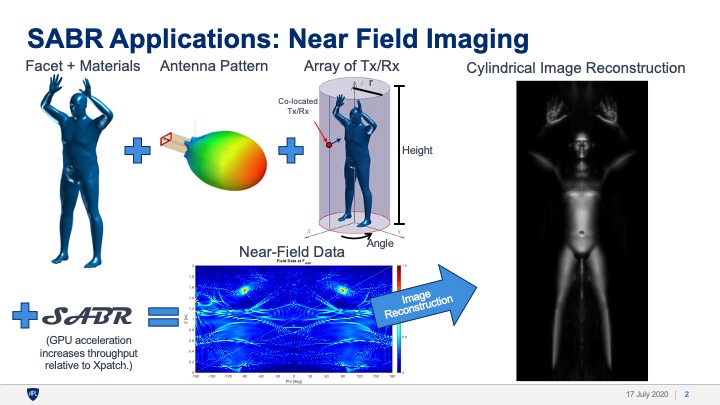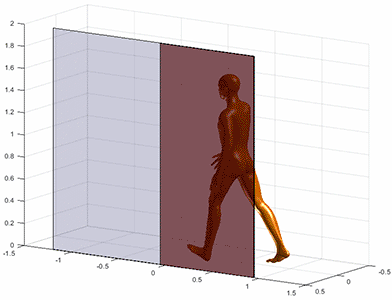News
Johns Hopkins APL’s SABR Simulations Give TSA Cutting-Edge Tech

Credit: Johns Hopkins APL
Imagine an airport security zone where travelers carrying small bags can walk right through a screening area without stopping. No lines, no traditional scanner, no pat-down. It might look like security measures had been seriously relaxed, but really, they are more effective than ever — and everyone even keeps their shoes on.
Johns Hopkins Applied Physics Laboratory (APL) scientists and engineers are helping the Transportation Security Administration (TSA) make this vision a reality.
APL tailored an internally developed software package called SABR (for Shooting and Bouncing Ray) to simulate the Advanced Imaging Technology (AIT) scanners used in airports.
SABR, which models various radio frequency (RF)-emitting technologies, relies on the same type of graphical processing units that enable video games and computer-generated imagery (CGI) seen in movies and TV shows. It uses shooting and bouncing rays to propagate energy through a scene, along with a technique called physical optics to approximate electrical and magnetic currents, integrate scattered fields and predict RF signatures.
“It’s similar to CGI, except instead of tracing from the light source to the camera, we’re tracing from the ‘camera,’ or transmitter, to the object and back,” said Shayne Gerber, the Signatures and Phenomenology section supervisor within APL’s Air and Missile Defense Sector. “Instead of calculating light reflections, we’re using electrical and magnetic currents to generate fields that integrate back to the receiver.”
Using SABR’s realistic simulations and 360-degree image-reconstruction capabilities, Lab researchers have created a Virtual AIT model. The model factors into a range of phenomenology studies that could shape which walkthrough scanners might eventually work. SABR’s rapid electromagnetic (EM) modeling capability simulates the progression of realistic virtual human models through an EM field, like a traveler passing quickly through a scanner. It’s fast enough to run computations previously too time-consuming and challenging to be practical. It can also generate synthetic AIT images to aid in developing machine-learning-based detection algorithms.

Credit: Johns Hopkins APL
“The Virtual AIT is helping us to transform what travel will look like in the future,” said Chris Thompson, who manages APL’s Transportation Security Systems program in APL’s Asymmetric Operations Sector. “Within this virtual environment, we are quickly and exhaustively able to investigate conditions for TSA that would otherwise be too costly and time-consuming to do in the real world. SABR, along with some of our other work, is enabling evaluations of multiple combinations of virtual people, threat objects and scanner configurations.”
“SABR allows modeling and simulation capabilities that would otherwise be impossible,” Gerber said. “These simulations will allow for investigations of scanner detection performance using thousands of different clothed human body shapes, in different walking configurations, and with or without threats. The improvements provide more and better data that allow users to develop better real-world capabilities.”
In recent years, the team has gone from virtual unknowns to experts in their field, working with Lab sponsors within the Department of Defense and the Department of Homeland Security.
“When I first began developing SABR, I never dreamed that we would be using it to model TSA scanners,” Gerber admitted.
Gerber was an APL intern in 2007 when he started developing SABR in his spare time, to model near-field scattering from the RF fuzing of an interceptor missile. Once he joined the Lab as a full-time employee, he improved the model with the help of collaborators across APL.
“Modeling technology had improved significantly from when I first started working on SABR,” Gerber said. “When the community wanted to start modeling the radar on the interceptor missile, we needed to account for a moving radar system in the near-field and partial illumination. Now, in the time it used to take a typical threat developer to develop radar cross-section (RCS) characterizations for a single threat, we can create characterizations for thousands of threats.”
Even with all of SABR’s potential applications, it was hard to find an initial use. One of its first was replacing the computational electromagnetic tools used to generate the precomputed RCS lookup tables that are used to represent various targets in radar simulations — a crucial pretest analysis input for the testing and evaluation program of an essential defense system. This allowed a massive reduction in up-front time and cost for building these RCS inputs.
“My section is kind of the outlier of the group, which is mainly focused on radar concepts and algorithms. We made an early decision to keep it as general a tool as possible so that it could have as many uses as possible, and that decision has paid off,” Gerber said with a smile. “Overall, I think this technology has made the Lab a leader in the field of RCS signatures. I think the applications are almost limitless.”
Because each sponsor has unique problems to solve, this leads to continual advances in SABR development. That range of applications is on display now as SABR is used to model various flight tests, air and ground vehicles, and weapons development for the Navy and Army, and now, body scanners for TSA and more potential applications.
“I’d love to see SABR out in the wild [working under various scenarios],” Gerber said. “It is a capability unique among the community, and we can use our tools like SABR to fill vital gaps and push the state of what’s possible.”
